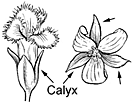Brush Box
Lophostemon confertus
Eucalyptus-Like family (Myrtaceae)
Post-Cook introduction
Large tree related to Eucalyptus, introduced in forest plantations. Planted as an ornamental and for shade. Differs from Eucalyptus by the leaves, which are crowded at the ends of twigs, and the very numerous united in five groups.

©2015 Zoya Akulova
Leaves mostly 4–5 at enlarged though borne singly (), gray hairy when young, becoming hairless. leaf-stalks slender, light green, 1⁄2–1 inch (13–25 ) long, flattened. Blades elliptical or narrowly 2 1⁄2–6 inches (6–15 ) long and 1–2 1⁄2 inches (2.5–6 ) wide, long-pointed at short-pointed at base, slightly thick and leathery, above dull green with light yellow and very fine side veins, beneath dull light green.
Flowers 3–7 clustered at the end of short flattened unbranched stalks 1⁄2–1 inch (13–25 ) long at leaf bases and back of leaves, white, fragrant, about 1 inch (2.5 ) across. cup () conical, 1⁄4 inch (6 ) long and broad, light green, hairy, bearing five pointed green five rounded white petals about 1⁄2 inch (13 ) long, short-stalked and hairy, and very numerous short threadlike white united in five columns 3⁄8 inch (10 ) long; with half inferior three-celled and threadlike
(seed capsules) 1–7 clustered at end of flattened stalk on twig back of leaves, cup-shaped, 3⁄8–5⁄8 inch (1–1. 5 ) in diameter, light green to brown, opening at flattened hard, three-celled. Seeds are many, light brown, less than 1⁄8 inch (3 ) long, narrow.
Sapwood is pale brown and heartwood pinkish to grayish brown. Wood heavy ( gr. 0.61), with fine texture and mildly interlocked grain but little figure. It has a relatively large shrinkage in drying and tends to warp in seasoning. It is not subject to severe growth stress problems in manufacturing as are certain eucalypts. Wood grown in Hawaii is moderately resistant to decay and termites. Wood from Australia is classed as very resistant to both. In Hawaii, it has been used for pallets, flooring, and pulp chips, generally mixed indiscriminately with the wood of Eucalyptus saligna. Elsewhere, used for construction, shipbuilding, bridges, railway crossties, and mallets. A sizable amount of flooring of this species has been imported to Hawaii from Australia.
Planted in moist areas of Hawaii in forest plantations and as a handsome shade tree. The Division of Forestry has planted more than 396,000 trees in the forest reserves on all islands, but mostly on Oahu and Hawaii. Oahu has 1.1 million board feet of timber and Hawaii 1.3 million. Trees may be seen at Waahila Ridge State Park (St. Louis Heights) and Keaiwa Heiau State Park (Aiea Heights). Also planted for shade in the Fort Street Mall in downtown Honolulu. Grown also in southern California and Florida.
Special areas
Wahiawa, Aiea, Tantalus
Champion
Height 60 ft (18.3 ), c.b.h. 12.9 ft (3.9 ), Spread 47 ft (14.3 ). Ulupalakua Ranch Co., Ulupalakua, Maui (1968).
Range
Native of east coast of Australia
Other common names
Brisbane-box, vinegartree
Botanical
Tristania conferta R. Br.







